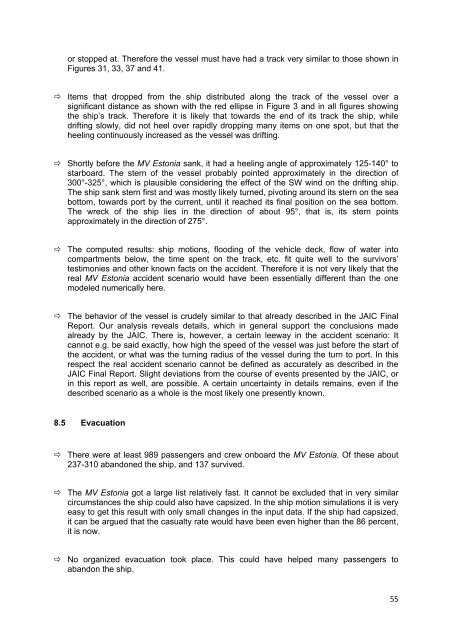SCHRIFTENREIHE SCHIFFBAU Festschrift anlässlich des 100 ...
SCHRIFTENREIHE SCHIFFBAU Festschrift anlässlich des 100 ...
SCHRIFTENREIHE SCHIFFBAU Festschrift anlässlich des 100 ...
Erfolgreiche ePaper selbst erstellen
Machen Sie aus Ihren PDF Publikationen ein blätterbares Flipbook mit unserer einzigartigen Google optimierten e-Paper Software.
or stopped at. Therefore the vessel must have had a track very similar to those shown in<br />
Figures 31, 33, 37 and 41.<br />
� Items that dropped from the ship distributed along the track of the vessel over a<br />
significant distance as shown with the red ellipse in Figure 3 and in all figures showing<br />
the ship’s track. Therefore it is likely that towards the end of its track the ship, while<br />
drifting slowly, did not heel over rapidly dropping many items on one spot, but that the<br />
heeling continuously increased as the vessel was drifting.<br />
� Shortly before the MV Estonia sank, it had a heeling angle of approximately 125-140° to<br />
starboard. The stern of the vessel probably pointed approximately in the direction of<br />
300°-325°, which is plausible considering the effect of the SW wind on the drifting ship.<br />
The ship sank stern first and was mostly likely turned, pivoting around its stern on the sea<br />
bottom, towards port by the current, until it reached its final position on the sea bottom.<br />
The wreck of the ship lies in the direction of about 95°, that is, its stern points<br />
approximately in the direction of 275°.<br />
� The computed results: ship motions, flooding of the vehicle deck, flow of water into<br />
compartments below, the time spent on the track, etc. fit quite well to the survivors’<br />
testimonies and other known facts on the accident. Therefore it is not very likely that the<br />
real MV Estonia accident scenario would have been essentially different than the one<br />
modeled numerically here.<br />
� The behavior of the vessel is crudely similar to that already <strong>des</strong>cribed in the JAIC Final<br />
Report. Our analysis reveals details, which in general support the conclusions made<br />
already by the JAIC. There is, however, a certain leeway in the accident scenario: It<br />
cannot e.g. be said exactly, how high the speed of the vessel was just before the start of<br />
the accident, or what was the turning radius of the vessel during the turn to port. In this<br />
respect the real accident scenario cannot be defined as accurately as <strong>des</strong>cribed in the<br />
JAIC Final Report. Slight deviations from the course of events presented by the JAIC, or<br />
in this report as well, are possible. A certain uncertainty in details remains, even if the<br />
<strong>des</strong>cribed scenario as a whole is the most likely one presently known.<br />
8.5 Evacuation<br />
� There were at least 989 passengers and crew onboard the MV Estonia. Of these about<br />
237-310 abandoned the ship, and 137 survived.<br />
� The MV Estonia got a large list relatively fast. It cannot be excluded that in very similar<br />
circumstances the ship could also have capsized. In the ship motion simulations it is very<br />
easy to get this result with only small changes in the input data. If the ship had capsized,<br />
it can be argued that the casualty rate would have been even higher than the 86 percent,<br />
it is now.<br />
� No organized evacuation took place. This could have helped many passengers to<br />
abandon the ship.<br />
55

















